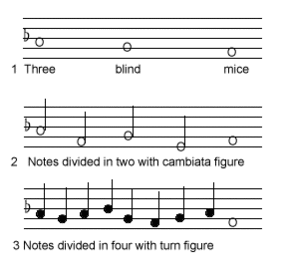Division (music)

In music, division refers to a type of ornamentation or variation common in 16th and 17th century music [1] in which each note of a melodic line is "divided" into several shorter, faster-moving notes, often by a rhythmic repetition of a simple musical device such as the trill, turn or cambiata on each note in turn, or by the introduction of nonchord tones or arpeggio figures.
The word was used in this sense to describe improvised coloratura ornamentation as used by opera singers of the day, but it made a ready way of devising variations upon a theme, and was particularly cultivated in the form of the "division on a ground" - the building of successively higher and faster parts onto a repeating bass-line. Examples of "divisions on a ground" were written by, among others, John Jenkins and Christopher Simpson.[2] Simpson gives a lengthy explanation of the art of free improvisation over an ostinato bass-line in his book The Division Viol (1665).
See also
References
- ↑ "Uniform Titles for Library Cataloguing". Yale University. Retrieved 2008-01-29.
- ↑ "Track Listing of Recording of Ayres and Divisions by William Lawes, Simpson, Jenkins and Purcell". Signum Records. Archived from the original on 2011-07-16. Retrieved 2008-01-29.